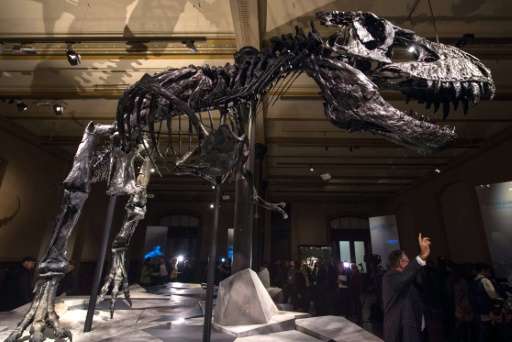Berlin gripped by T-rex fever as 'Tristan' stomps into town

A towering, 12-metre (40-foot) long Tyrannosaurus rex skeleton with a terrifying jaw goes on display in Berlin's Natural History Museum from Thursday.
Hoping that dino frenzy will drive a visitor boom, the museum Wednesday invited media to a face-to-face encounter with the 66-million-year-old beast called "Tristan".
The prehistoric predator is considered one of the most complete skeletons among the 50-odd sets of T-rex remains that have been unearthed worldwide, many in the hands of private collectors and out of public view.
Tristan has come to the German capital for an at least three year long stint courtesy of Danish businessman and large-fossil collector Niels Nielsen, who said he named it after his son.
"Dinosaurs attract people to museums" and such exhibits "encourage children to take an interest in research," said Nielsen during the presentation of Tristan.
Local media celebrated the eye-catching loan, with one newspaper running a picture of the ancient reptile on its front page with the headline "Ich bin ein Berliner", the famous words of former US president John F. Kennedy.
Education and Research Minister Johanna Wanka hailed the dino as a "spectacular find", which would find a good temporary home in the museum known for its "unique collection and excellent research".
The four-metre-tall dinosaur, whose scientific name means "tyrant lizard", was unearthed from 2010-12 in the US state of Montana.
Berlin museum staff painstakingly re-assembled the matt-black fossilised skeleton from 300 separate parts, 170 of which are original, the rest reproductions.
A team of 70 scientists will keep studying the remains, including the dinosaur's 180-kilogramme (400 pound) skull, to try to ascertain its age and learn more about its environment and menu.
"The T-rex, was he mainly a predator or rather a carrion eater? The picture we have is changing, and it's exciting," enthused Uwe Moldrzyk, in charge of the wider multi-media exhibition "Tristan - Berlin bares its teeth".
Paleontologists have already discovered one tidbit about the giant carnivore: Tristan suffered from dental problems and a swelling of the jaw, perhaps due to a bone tumour.
The museum already boasts one of the world's best collections of dinosaur fossils, which were discovered mainly in Tanzania in the early 20th century.
Keeping the flesh-chomping newcomer company at the museum will be a long-time vegetarian resident, a Brachiosaurus with a 13-metre-long neck.
© 2015 AFP

















